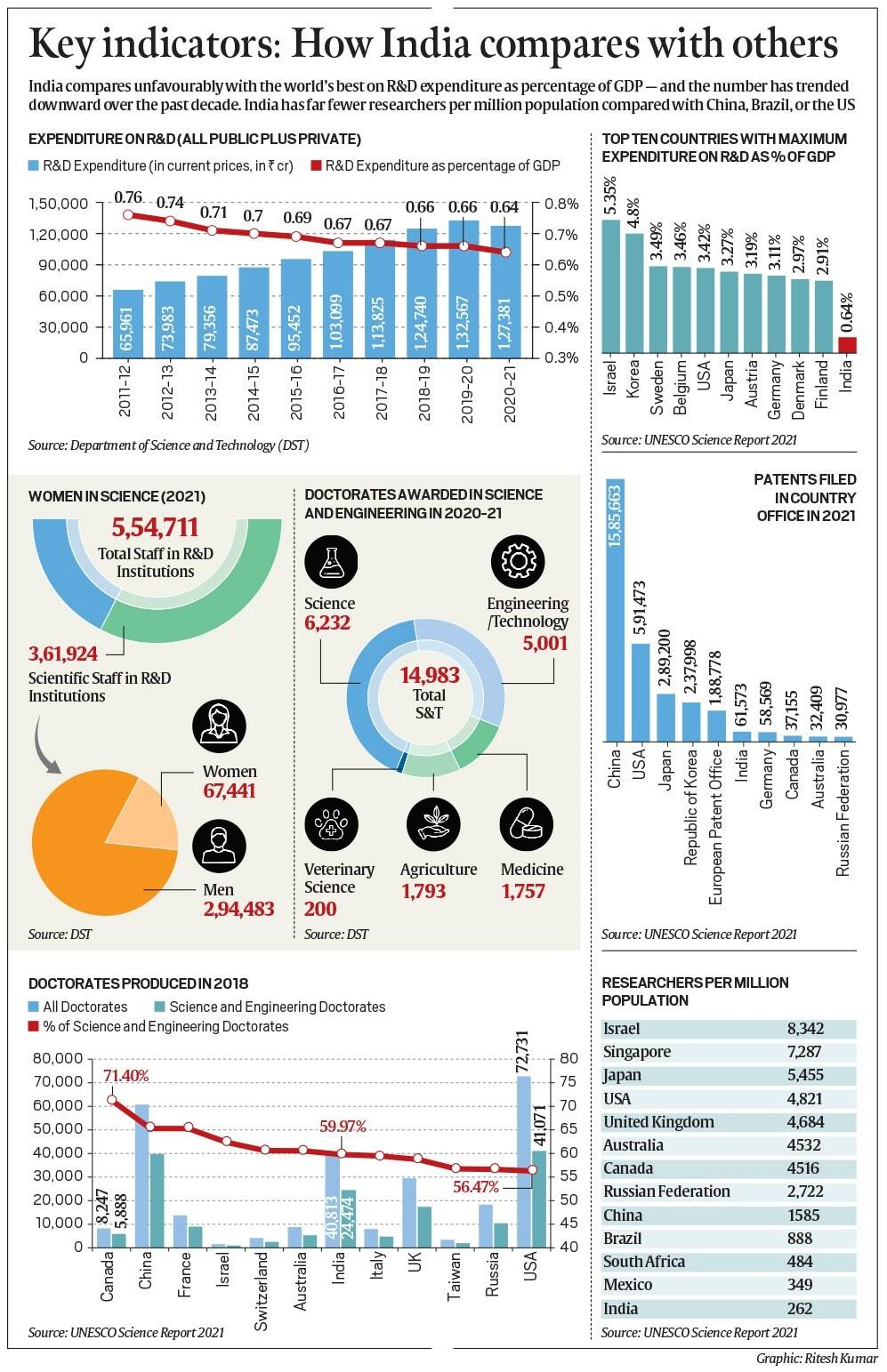Description

Copyright infringement not intended
Context: The government’s approval for a National Research Foundation (NRF) is being widely welcomed by the scientific community as an effort to improve the state of scientific research in India.
Details
- The Union Cabinet approved the National Research Foundation (NRF) Bill 2023, which will establish NRF as an apex body to provide high-level strategic direction to scientific research in the country
State of Science Research in India
- Science research is vital for the economic and social development of any country. It contributes to the creation of new knowledge, technologies, products, and solutions that can enhance the quality of life and well-being of people. It also helps to solve global challenges such as climate change, health, energy, and food security.
- India is a country with strong scientific capabilities, as evidenced by its large pool of science and engineering graduates, its extensive network of laboratories and research institutions, and its active participation in some of the cutting-edge areas of scientific research, such as supercomputing and quantum technologies. However, India also faces several challenges in advancing its scientific research and innovation, compared to other countries.

Expenditure on Research and Development
- One of the key factors that affect India's innovation potential is the amount of funds allocated for research and development activities.
- Despite having a long-standing goal of spending at least 2% of its GDP on R&D, India has failed to achieve this target for over 20 years. The ratio of research expenditure to GDP has declined from around 0.8% in the early 2000s to about 0.65% currently. This indicates that the growth of research funding has not kept pace with the growth of the economy.
- The absolute amount of money allocated for R&D has increased more than threefold in the last 15 years, from Rs 39,437 crore in 2007-08 to over 1.27 lakh crore in 2020-21, but this is not enough to keep pace with the global trends.
- According to the 2021 UNESCO Science Report, India ranked 38th among the countries that spent more than 1% of their GDP on R&D in 2018, the latest year for which data is available. Only 15 countries managed to spend more than 2% of their GDP on R&D that year. The world average was 1.79%.
- India's total expenditure on R&D in purchasing power parity (PPP) terms in 2018 was about US$ 68 billion, which placed it 6th in the world, after the US, China, Japan, Germany and South Korea. However, there was a huge gap between India and the top five countries. The US and China both spent more than US$ 500 billion on R&D in 2018.
- Another indicator of India's poor performance in R&D is the low spending per researcher.
- India spent only 42 US dollars (in PPP terms) per researcher in 2020, while Israel, South Korea and the US spent more than 2,000 US dollars per researcher.
- India also has a low proportion of women researchers, at only 18%, compared with the global average of 33%.
These statistics show that India needs to step up its efforts to boost its R&D sector, which is crucial for innovation, competitiveness and economic growth.
Research in Universities
- India has a large number of higher education institutions, but only a few of them are involved in research. Out of the nearly 40,000 colleges and 1,200 universities in the country, only 1% of the universities conduct active research, as per the detailed project report on NRF. This is a stark contrast to other countries, where universities are the main hubs of research and development activities.
- According to the Department of Science and Technology (DST), there were 7,888 R&D institutions in India in 2021, including more than 5,200 units in the private sector and industries. However, these units mostly engage in industry-specific research, and not in fundamental research.
- The private sector units also include 921 industries that have the potential to undertake research activities but may not be doing so.
Research output
- The DST data shows that India has a strong presence in science and engineering doctorates, both at home and abroad.
- In 2020-21, India awarded 25,550 doctoral degrees, out of which 14,983 were in science and engineering fields. This means that 59% of the Indian doctorates were in these disciplines, which is a high ratio compared to other countries.
- India ranked 7th in the world in terms of the total number of science and engineering doctorates produced. However, when we consider the population size of India, the picture is less flattering. India has only 262 researchers per million populations, which is much lower than many other developing countries, such as Brazil (888), South Africa (484) or Mexico (349).
- A large number of Indians pursue their doctoral studies in the US, especially in science and engineering fields. Between 2001 and 2020, 36,565 Indians obtained a doctorate at a US university, and 94% of them (34,241) did so in science and engineering disciplines. This puts India second only to China in this category.

Publications and Patents
- The number of publications and patents produced by Indian researchers has increased significantly in the last decade, according to data from DST.
- In 2020, Indian researchers published 149,213 articles in science and engineering journals worldwide, a 150% increase from 2010. However, this still represented only 5% of the global share of articles. China and the US were the leading contributors, with 23% and 15.5% respectively.
- India ranked 6th in the world in terms of patent filings in 2021, with a total of 61,573 patents. However, this was far behind the patent filings in China and the US, which were 16 lakh and 6 lahks respectively that year.
Initiatives taken by Government
- The Digital India programme aims to transform the public service delivery system through digital technologies and foster a digital economy.
- The Make in India programme seeks to boost manufacturing and related infrastructure and encourage foreign direct investment and technology transfer.
- The Start-up India initiative supports entrepreneurship and innovation by providing tax benefits, funding, mentoring, and ease of doing business.
- The National Skills Development Mission targets to train about 400 million people by 2022 in various skills, including science and technology.
- The National Artificial Intelligence Strategy outlines a vision and roadmap for harnessing the potential of AI in various sectors and domains.
- Increasing the budget allocation for science and technology by 30% in 2022-23, with a focus on basic and applied research, human resource development, and international collaboration.
- Launching the National Research Foundation (NRF), a new umbrella organization that will fund, coordinate, and monitor all research activities across various disciplines and sectors.
- Establishing the Prime Minister's Science, Technology and Innovation Advisory Council (PM-STIAC), a high-level body that will advise the government on strategic priorities, policies, and programs for science, technology and innovation.
- Implementing the New Education Policy (NEP) 2020 aims to transform the education system by integrating scientific temper, creativity, and critical thinking among students and teachers, and by creating more opportunities for interdisciplinary and multidisciplinary learning.
- Enhancing the quality and quantity of scientific publications and patents by providing incentives, recognition, and support to researchers and institutions.
- Strengthening the industry-academia linkages by facilitating technology transfer, incubation, entrepreneurship, and innovation ecosystems.
- Expanding international cooperation and partnerships in science research by participating in mega-science projects, hosting global events, and signing bilateral and multilateral agreements.
These steps are expected to boost the state of scientific research in India and enable India to emerge as a global leader in science and innovation in the 21st century.
|
National Research Foundation (NRF) Bill 2023
●The government has taken several steps to improve the state of science research in India. One of these steps is the approval of the National Research Foundation (NRF) Bill 2023, which will establish NRF as an apex body to provide high-level strategic direction to scientific research in the country.
●The NRF will fund basic, applied, and translational research across all disciplines; promote collaboration among researchers; foster a culture of innovation and entrepreneurship; enhance equity and inclusion in research; monitor and evaluate research outcomes; and facilitate international linkages and partnerships.
|
Way Forward
- The way forward for improving the state of scientific research in India is to create an enabling environment that supports excellence, innovation, diversity, and relevance in scientific research. This requires a concerted effort from all stakeholders, including the government, academia, industry, civil society, media, and the public.
Some of the possible measures that can be taken are:
- Increasing public investment in R&D to at least 2% of GDP.
- Enhancing private sector participation and contribution to R&D.
- Strengthening research infrastructure and facilities across the country.
- Improving research quality and impact through peer review, incentives, awards, and rankings.
- Encouraging interdisciplinary and multidisciplinary research collaborations.
- Promoting women's participation and leadership in scientific research.
- Developing human capital and talent for scientific research through education, training, mentoring, and career development.
- Fostering a culture of innovation and entrepreneurship among researchers.
- Aligning research priorities with national needs and global challenges.
- Engaging with society and media to communicate the value and benefits of scientific research.
These measures can help India achieve its potential as a global leader in scientific research and contribute to its social and economic development and well-being.

Conclusion
- Science research is vital for the progress and development of any country. India has a rich legacy and a huge potential for scientific research, but it also faces several challenges that need to be addressed urgently. By increasing funding, attracting talent and fostering culture, India can improve the quality and quantity of its scientific output and become a global leader in scientific research.
Must-Read Articles:
Women in STEM: https://www.iasgyan.in/daily-current-affairs/women-in-stem
NATIONAL RESEARCH FOUNDATION (NRF) BILL: https://www.iasgyan.in/daily-current-affairs/national-research-foundation-nrf-bill
|
PRACTICE QUESTION
Q. India is a country with a rich heritage of scientific achievements and a vibrant community of researchers. However, it also faces many challenges in advancing its science research agenda. How can India overcome these obstacles and foster a culture of innovation and excellence in scientific research? What are the opportunities and benefits of investing more in science research for India's development and global leadership?
|
https://indianexpress.com/article/explained/explained-sci-tech/national-research-foundation-approved-state-of-science-where-india-lags-8751448/

















